|
|
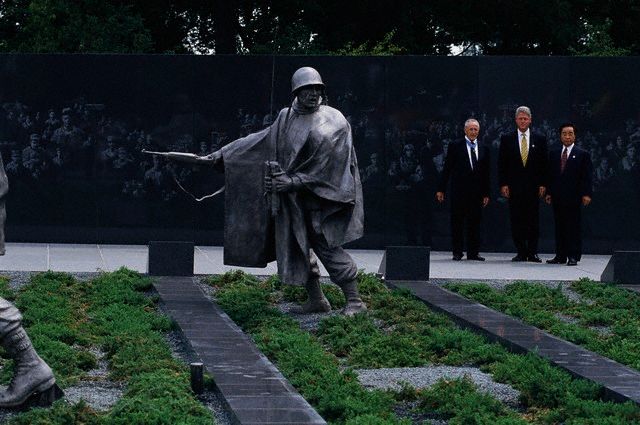
Dedication Ceremony for the Korean War Veterans Memorial by Frank Chalfant Gaylord II, Louis Nelson and Others - General Raymond Davis, President Bill Clinton, and South Korean President Kim Young Sam stand alongside the Korean War Veterans Memorial during the July 27, 1995 dedication ceremony.
Several components merge to form monument
Battle-ready soldiers wade through a carpet of low shrubs, past a wall of faces etched in stone, and forward toward their objective - an American flag waving high above a pool of rippling water. The image is the newest addition to the National Mall. It is a memorial honoring those who served in the Korean War.
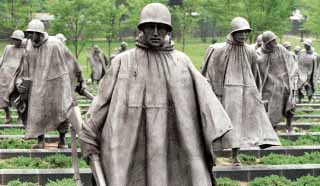 The statues The statues
Height:7'3'' to 7'6''
Weight:1,000 pounds
Material:Roughened stainless steel
Plodding in a V-formation, in wind-whipped ponchos, 19 men in full gear trek over a field of juniper. Graphite beams stretching horizontally between them act as obstacles. The ethnically diverse group represents those who fought the war on foot: 14 are Army troops, three are Marines, one a Navy corpsman and one an Air Force forward observer. The 19 are reflected in the wall to their right, doubling their number to 38 - a reference to the 38th parallel dividing North and South Korea.
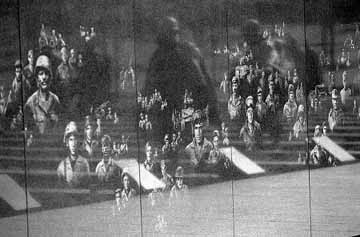 The wall The wall
Length:164 feet
Width:8 inches
Weight:100 tons
Material:Polished granite
A mural of more than 2,500 documentary photographs sandblasted into a graphite wall tells the story of the men and women who provided land services and air and sea support for ground troops. The images are taken from military archives.
From a distance, the faces of nurses, chaplains, mechanics and other support personnel soften and blend together, providing a backdrop for the statues that echoes the rolling hills of Korea.
The images are not identified by name, rank or serial number, but are grouped by service: Army on the left, Air Force in the middle, and Navy/Marines on the right. Visitors may make rubbings of the images.
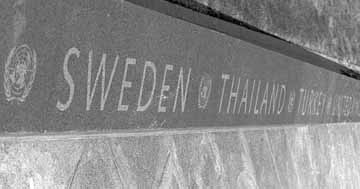 The walkway The walkway
A granite curb lines the path stretching toward the reflecting pool. On it are the names of the 22 nations, in alphabetical order, participating in the United Nations' effort in Korea. The names of the countries, beginning with Australia and ending with the United States, are separated by the U.N. symbol. The walkway completes the "Field of Service" - the triangular area on which the wall and 19 statues stand.
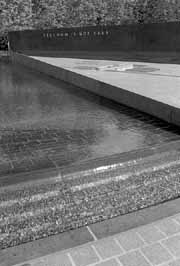 The pool of remembrance The pool of remembrance
Diameter:30 feet
Base material:Highly reflective black granite
Water glides over black granite, seemingly motionless until it gently falls over the edge of the circular base.
The tip of the triangular area on which the 19 soldiers and graphite wall stand, slices into the center, providing a foundation for a flag.
Circling the pool, benches and linden trees provide an area for rest and reflection. In the background, flowering Rose of Sharon shrubs, the national flower of South Korea, will eventually form a hedge against the outside.
A wall bearing the inscription"Freedom is not free"stands separate from the wall of faces. But what is the cost of freedom? As an answer, the Allied toll in the Korean War, 1950-1953, is etched on the lip of the pool:
USA U.N.
Dead 54,246 628,833 Missing 8,177 470,267 Captured 7,140 92,970 Wounded 103,204 1,064,453 Memorial facts, figures
Acreage:2.2
Cost:$18 million, raised through donations. $1 million provided by the federal government was returned.
Ground broken:June 14, 1992, by President Bush.
Hours of operation:24 hours a day. At night, lights illuminate the wall, statues and flag.
Remarks at the Unveiling Ceremony for the Design of the Korean War Memorial
June 14, 1989
Thank you all. Thank you, General Davisand General Stilwell; General Goodpaster; our Commandant, General Gray; Secretary Lujan; members of the Commission; winners; second place winners; third place winners; fellow veterans; distinguished guests; leaders of the Congress. It is a pleasure to welcome you to the White House, and I want to thank you for the privilege of sharing this occasion.
Woodrow Wilson once said: ``A patriotic American is never so proud of his flag as when it comes to mean for others, as to himself, a symbol of liberty.'' Well, fittingly, we meet here on Flag Day and the day of the U.S. Army's founding, and as patriotic Americans, to publicly unveil the winning design of a symbol of liberty -- the Korean War Veterans Memorial.
And there are, of course, many such symbols in this great Capital of ours, memorials which rightly hail veterans from Bunker Hill to Gettysburg to the rice paddies of Vietnam. And they are a part of our history and of our lore, monuments to the dead and the living. But until recently, the Korean war was not formally remembered, nor were the over 5.7 million American servicemen and women who were directly and indirectly involved. And today we say: No more! It's time to remember, for we are here to pay tribute to America's uniformed sons and daughters who served during the Korean conflict and to recall an American victory that remains too little appreciated and too seldom understood.
We recall that when the war began the forces of totalitarianism seemed ready to overrun all of Asia; but it never happened. For Korea was the first allied effort in history to contain communism by combining strength. Fighting side by side under the flag of the United Nations, the freedom-loving countries of the United States and the Republic of Korea and other allies strove to halt aggression. And we succeeded and built a stable peace that has lasted for more than 35 years. And together, we held the line.
And today we are still holding it -- and let me salute those American troops who guard the 38th parallel. And I want to salute our allies, for they, too, have sacrificed on freedom's behalf. And what will happen in much of Asia, we can't be sure; but of this we are certain: In retrospect, the policy of containment so exemplified by the Korean conflict created the conditions for the tide toward democracy now changing and uplifting our globe.
The design we unveil today honors that democracy and the American men and women who took up arms and bore our burden so that freedom could survive. And our nearly 5 million Korean war veterans alive today -- we honor them. Our 103,000 wounded in the conflict -- we honor them; our more than 8,000 missing or unaccounted for; the 54,246 Americans who gave their lives, who gave, as Lincoln said, ``the last full measure of devotion.''
This day marks another step toward the memorial that Korea's veterans deserve and will have, a process which began when President Reagan signed legislation authorizing the creation of a Korean War Veterans Memorial in the District. And last September a site was approved for the Washington Mall. The memorial will be built in Ash Woods, a grove of trees near the Lincoln Memorial, across the reflecting pool from the Vietnam Memorial. And its existence will be due to a number of friends. Among them are members of both parties who helped pass this legislation and, of course, the sponsors of this memorial. And in that context, I would like to thank the Battle Monuments Commission -- ably chaired by General Goodpaster, who was years ago, right in this building, the Staff Secretary to President Eisenhower -- and also the Korean War Veterans Memorial Advisory Board.
And now let me thank the men and women who chose this design. And to Chairman Ray Davis, my special thanks for chairing the committee. I want also to repeat, as General Stilwell has noted, that every dollar of this funding has been privately financed; and to commend, as he did, Max Jamiesson, whose company donated $1 million, and then Abby -- ``Dear Abby,'' Abigail Van Buren, whose readers raised, almost unbelievably, $330,000 for the veterans memorial.
General Davis has observed how the design for their -- rather, for your memorial was crafted by four professional architects and designers on the faculty of Penn State, the department of agriculture [architecture]. You met them -- Dr. Leon, Oberholtzer, and John and Veronica Lucas. And to all of them, my congratulations. Somehow it seems that you might even eclipse Joe Paterno [football coach at the university] and the Nittany Lions as Penn State's most noted team.
But let me add that I look forward to the day when the memorial itself is unveiled, for it will stand as America's lasting tribute to those who fought so valiantly in an unknown land, as liberty's Horatio at the bridge. And as you view it, think of such names as Ridgway and Van Fleet, MacArthur, shell-torn uplands, Pork Chop, Bloody Arrowhead. Remember Panmunjom and, yes, Inchon and the heroism of the soldiers who fought across the rugged, snow-covered hills.
Think of men like James Garner, Neil Armstrong, or the many Members of the United States Congress who served in Korea -- Warren Rudman among them, and John Glenn -- and John's wingman, Ted Williams -- Ballgame Teddy, they called him, greatest hitter who ever lived -- or General Al Gray, sitting right here, who volunteered twice to serve on the front line, first as an enlisted marine and later as a commissioned officer, courageously leading an infantry platoon -- heroes who showed that ours would not be the land of the free if it were not also the home of the brave.
And, yes, think of them, honor them, remember how they served from Pusan to Pyongyang, heroes like Rosemary McCarthy, a courageous Army nurse; or our good friend -- my good friend -- Pete McCloskey, who endured superior forces to charge up and take his hill and whose troops so admired him that they named a baseball field in his honor in Korea; or Wally Lukens, who braved enemy fire to replace another platoon leader, then picked up a gravely wounded infantryman and carried him to the rear. His effort to save that life was in vain, but his selfless devotion to his men -- his grit and his guts -- lives on in the souls of all Americans in uniform today.
To my right sits such an American -- stands such an American -- he's supposed to be seated -- Ray Davis. He was a lieutenant colonel during the war, received the Congressional Medal of Honor.And 37 years ago, in this very place, President Truman, himself a veteran, presented the medal; and then he said, ``Colonel, I'd rather have this than be President.'' Ray Davis won his medal for you and for me and our country, and he's wearing it today.
And it makes us proud, and so will this design of the veterans memorial. It speaks of walking toward freedom and toward home, in the cold that was Korea. Mike McKavitt was a fighter pilot in Korea, and he tells me he couldn't sleep for 3 nights after first seeing this memorial. And now we all are about to see why. So, could we move over and do the honors.
Note: The President spoke at 2:14 p.m. in the Rose Garden at the White House. In his remarks, he referred to Gen. Raymond G. Davis, USMC, Ret.; Gen. Richard G. Stilwell, USA, Ret.; and James D. ``Mike'' McKavitt, vice chairman, chairman, and member of the Korean War Veterans Memorial Advisory Board, respectively; Gen. Andrew J. Goodpaster, USA, Ret., Chairman of the American Battle Monuments Commission; Gen. A.M. Gray, Jr., Commandant of the Marine Corps; Secretary of the Interior Manuel Lujan, Jr.; Max Jamiesson, executive vice president and chief operating officer of Hyundai Motor America; actor James Garner; astronaut Neil Armstrong; Senators Warren Rudman of New Hampshire and John Glenn of Ohio; Ted Williams, former member of for the Boston Red Sox; and Paul N. ``Pete'' McCloskey, Jr., former Representative from California.
|
|
|
|
|
 Articles & Briefings
Articles & Briefings
